Louisiana is home to a fascinating variety of doves, each with its own unique traits and behaviors. From the gentle Mourning Dove to the striking White-winged Dove, these birds are a common yet captivating sight across the state.
Doves can be found in cities, farmlands, woodlands, and even coastal areas of Louisiana. Their soft calls, graceful flights, and adaptable feeding habits make them an important part of the state’s birdlife and culture.
In this guide, we’ll explore seven types of doves found in Louisiana, highlighting their identification, size, habitat, diet, and fun facts. With this knowledge, birdwatchers can easily recognize these species and appreciate their presence in local environments.
Different Types of Doves Found in Louisiana
Mourning Dove (Zenaida macroura)
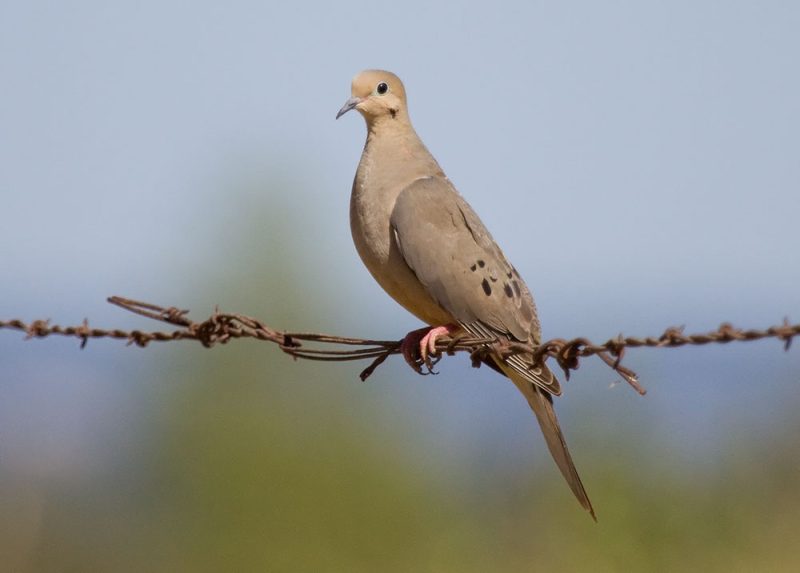
The Mourning Dove is one of the most recognizable doves in Louisiana, known for its slender body, long pointed tail, and soft grayish-brown plumage with black spots on the wings. Adults typically measure around 9 to 13 inches in length and weigh about 4 to 6 ounces. Their small heads and distinctive dark eyes give them a gentle expression, while their rapid, direct flight often produces a whistling sound as air passes through their wings.
This species is highly adaptable and can be found across Louisiana in open fields, farmlands, suburban yards, and along roadsides. They are most active during early mornings and late afternoons when they forage on the ground for food. Their diet consists mainly of seeds from grasses, weeds, and cultivated crops such as corn, millet, and sunflower. Unlike some other birds, they swallow seeds whole and store them in their crop before digesting them gradually.
The Mourning Dove’s cooing call is one of its most distinctive features, often described as a mournful, haunting sound that inspired its name. Breeding season in Louisiana begins as early as March and may continue into late summer. Pairs build flimsy nests of twigs in trees, shrubs, or even on man-made structures. Females usually lay two white eggs, and both parents share incubation duties for about two weeks.
A fun fact about the Mourning Dove is that it is one of the most hunted game birds in North America, yet its population remains stable due to its high reproductive rate—pairs can raise up to six broods per year. In Louisiana, these doves are widespread throughout the state, from rural farmlands to suburban neighborhoods, making them one of the most familiar birds to residents.
White-winged Dove (Zenaida asiatica)
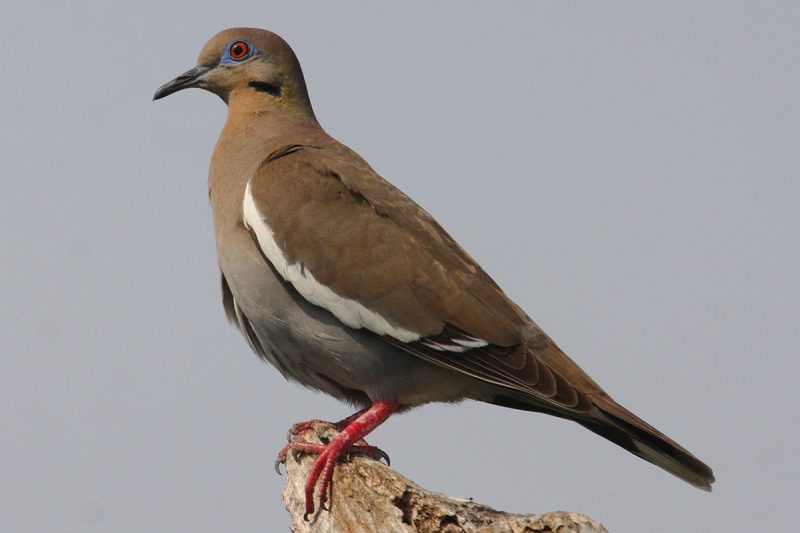
The White-winged Dove is slightly larger than the Mourning Dove, measuring about 11 inches in length with a wingspan of up to 18 inches. Its plumage is light brown overall, but it is easily identified by the bold white stripe along the edge of each wing, which becomes very noticeable in flight. It also has a distinctive blue ring around its eyes and a slightly more robust body than its Mourning Dove relative.
This dove prefers warm, open habitats and is commonly found in southern Louisiana, especially in areas with agricultural fields, wood edges, and suburban gardens. It feeds mainly on grains, seeds, and berries, often gathering in flocks to forage in fields after harvest. In urban areas, it is not uncommon to see them visiting backyard feeders stocked with millet and sunflower seeds.
The White-winged Dove’s call is a rhythmic “who-cooks-for-you” sound, deeper and more deliberate than the Mourning Dove’s coo. Breeding season begins in spring, with nests often built in trees, shrubs, or even on utility poles. Like other doves, they typically lay two eggs per clutch. Parents are known for feeding their young “pigeon milk,” a nutrient-rich secretion produced in the crop, ensuring rapid growth of chicks.
A fun fact is that White-winged Doves played an important role in the ecosystem of the American Southwest by pollinating saguaro cacti when feeding on their nectar, although in Louisiana they rely more on agricultural crops. Their range has expanded significantly over the past century, and they are now well established across Louisiana, particularly in the southern and central regions.
Eurasian Collared-Dove (Streptopelia decaocto)

The Eurasian Collared-Dove is a relatively new arrival in Louisiana, having spread across North America only in the past few decades. It is medium-sized, about 12 to 13 inches long, with pale gray plumage and a distinctive black “collar” or crescent on the back of its neck. Its broad tail with white edges is also a helpful identification feature. Compared to native doves, it appears slightly bulkier with a more deliberate flight.
This species thrives in human-modified environments and is often seen in towns, suburbs, and agricultural areas throughout Louisiana. It feeds primarily on grains and seeds, often foraging near bird feeders, barns, or grain storage areas. Because they are not migratory, Eurasian Collared-Doves can be spotted year-round across the state, even in colder months when other bird species may migrate southward.
The call of the Eurasian Collared-Dove is a distinctive three-part cooing sound, often repeated several times in succession, which sets it apart from the Mourning Dove’s mournful coo. Breeding occurs throughout most of the year in Louisiana’s mild climate, and like other doves, they lay two eggs per clutch. Their adaptability allows them to nest in trees, on rooftops, or on utility structures, making them very successful in urban areas.
A fun fact is that the Eurasian Collared-Dove’s rapid expansion across North America began after a few individuals escaped captivity in the Bahamas in the 1970s. From there, they spread quickly and are now a common sight across Louisiana. Today, they can be found statewide, particularly around farms, grain elevators, and residential neighborhoods.
Ringed Turtle-Dove (Streptopelia risoria)

The Ringed Turtle-Dove is closely related to the Eurasian Collared-Dove and is often mistaken for it, but it is generally smaller and paler in color. Adults average around 11 inches in length, with soft beige or cream-colored plumage and a narrow black collar at the nape of the neck. Unlike the Eurasian species, the Ringed Turtle-Dove shows more uniform coloring without the gray tones, giving it a more delicate appearance.
This dove is primarily associated with urban and suburban environments in Louisiana. While it is often kept as a domestic or ornamental bird, some individuals have established feral populations in certain areas of the state. They thrive around neighborhoods, gardens, and parks, often frequenting bird feeders where they consume millet, cracked corn, and sunflower seeds.
The Ringed Turtle-Dove’s song is a familiar “coo-coo-coo” series, softer and less resonant than that of the Eurasian Collared-Dove. Their breeding behavior is similar to other doves, with pairs forming strong bonds and reusing the same nesting sites multiple times in a year. Clutches consist of two eggs, and young are fed pigeon milk until they are strong enough to feed on seeds.
A fun fact is that Ringed Turtle-Doves are considered partially domesticated, with a long history of being bred in captivity as pets or ornamental birds. Escaped individuals have occasionally formed small wild populations in Louisiana, though they are less widespread than Eurasian Collared-Doves. Their distribution in the state is patchy, but they are more often observed near urban centers where captive releases or escapes occur.
Common Ground-Dove (Columbina passerina)
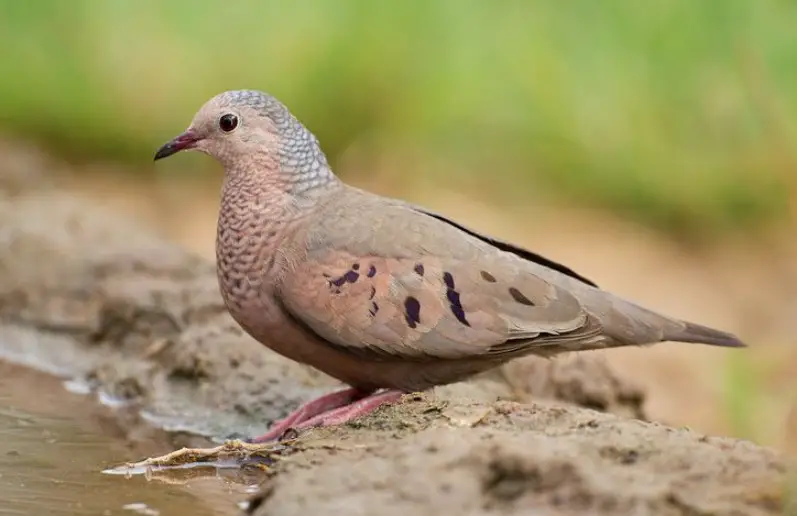
The Common Ground-Dove is the smallest dove species in Louisiana, measuring only 6 to 7 inches long and weighing about 1 ounce. Its plumage is a warm brownish-gray with scaled patterns on the neck and breast, giving it a slightly mottled look. The short tail and reddish bill with a black tip help in identification. Despite its small size, it has a surprisingly rapid and direct flight.
This dove prefers open, sandy, or brushy habitats and is often found in southern Louisiana along woodland edges, fields, and overgrown lots. It spends most of its time foraging on the ground, walking quietly as it searches for seeds. Unlike larger doves that often gather in large flocks, the Common Ground-Dove is usually seen in pairs or small groups, making it less conspicuous.
Its call is a distinctive soft “coo” or “whoo” sound, often repeated in a gentle series. Breeding occurs in Louisiana from spring through late summer, with nests usually placed close to the ground in shrubs or low vegetation. Females typically lay two eggs per clutch, and both parents share incubation and chick-rearing duties.
A fun fact is that when startled, the Common Ground-Dove produces a loud fluttering sound with its wings, which may help distract predators. In Louisiana, they are more commonly found in the southern part of the state, particularly near the Gulf Coast where sandy soils and shrubby cover provide ideal habitat.
Inca Dove (Columbina inca)
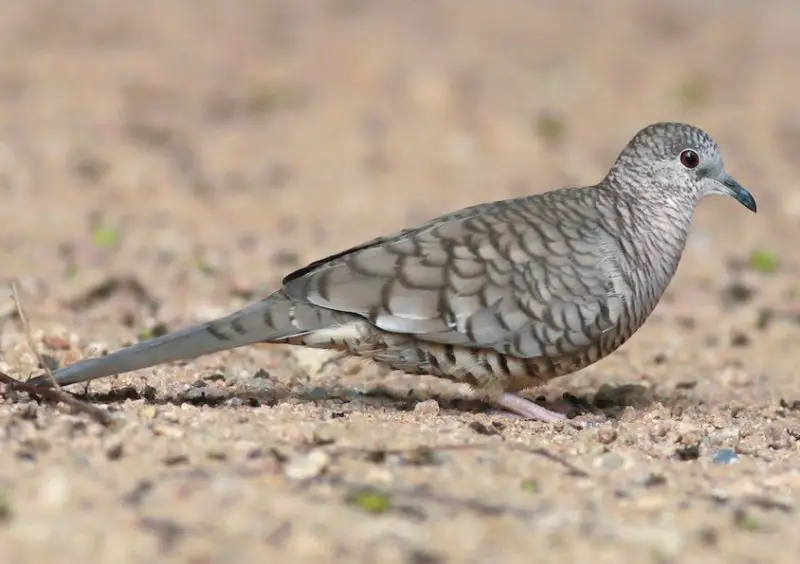
The Inca Dove is a small dove species with a body length of about 8 inches and a wingspan of around 12 inches. It is easily recognized by its unique scaly feather pattern, where each feather has a dark edge, giving the bird a checkered or scaled appearance. Its long, slender tail, edged with white, makes it stand out when flying.
Inca Doves are typically found in towns, suburbs, and farmlands across southern Louisiana. They are frequent visitors to backyard feeders, where they feed on millet, cracked corn, and other small seeds. Unlike other doves, they are known to roost communally in cold weather, with several individuals huddling together in a line to conserve heat.
The call of the Inca Dove is a distinctive two-syllable “coo-coo,” often sounding higher pitched and more rapid than the Mourning Dove’s song. Their breeding season in Louisiana can extend for much of the year, thanks to the warm climate. Like other doves, they typically raise two chicks per clutch, and both parents contribute to feeding the young with pigeon milk.
A fun fact is that the Inca Dove has been observed performing a unique behavior called the “feather shuffle,” where it raises and lowers its wings to flash the white edges of its tail during courtship or when startled. In Louisiana, these doves are found mostly in southern and central regions, thriving in areas with human activity.
Rock Dove (Columba livia)
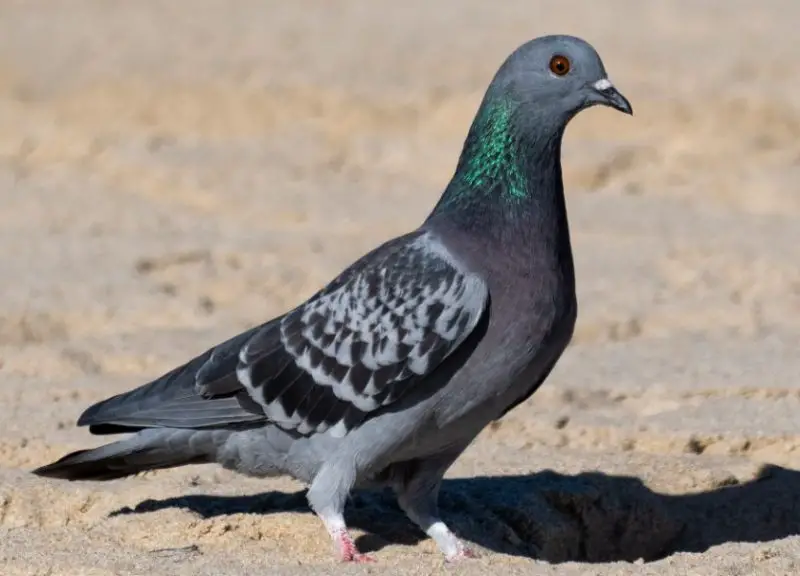
The Rock Dove, more commonly known as the Rock Pigeon, is a familiar sight in Louisiana’s towns and cities. Adults measure about 12 to 14 inches long with a wingspan of up to 26 inches. Their plumage is highly variable, ranging from the classic bluish-gray with two black wing bars to white, brown, or mottled forms due to selective breeding and feral populations. They have iridescent feathers on the neck that shimmer green and purple in sunlight.
These birds are highly adapted to urban environments, nesting on building ledges, bridges, and other man-made structures that resemble their ancestral cliffside habitats. They feed mainly on grains, seeds, and food scraps provided by humans. In Louisiana, Rock Doves are widespread in cities like New Orleans, Baton Rouge, and Lafayette, where they gather in large flocks around parks, streets, and public squares.
The Rock Dove’s cooing is a familiar sound in urban settings, often used in courtship displays. They breed year-round in Louisiana’s mild climate, laying two eggs per clutch and often raising multiple broods annually. Nests are usually made of twigs, straw, and other debris found in urban environments.
A fun fact is that Rock Doves were domesticated thousands of years ago and have played important roles in human history as messengers and racing birds. In Louisiana today, they are considered an introduced species but remain an integral part of cityscapes, coexisting closely with human populations.
FAQs about Doves in Louisiana
Are Mourning Doves common in Louisiana?
Mourning Doves are among the most common dove species in Louisiana. They thrive in both rural and urban areas, from open farmlands and fields to city parks and backyards. Their adaptability and high reproductive rate allow them to remain abundant throughout the state.
Do White-winged Doves migrate to Louisiana?
Yes, White-winged Doves migrate into Louisiana, especially during warmer months. They are most often seen in southern and central parts of the state, where agricultural fields and suburban gardens provide excellent feeding grounds. Some populations may remain year-round in mild areas.
How can you tell the difference between Eurasian Collared-Doves and Ringed Turtle-Doves?
The Eurasian Collared-Dove is slightly larger, grayer, and more robust, while the Ringed Turtle-Dove appears smaller and paler with a cream-colored plumage. Both species have a black collar on the neck, but the Ringed Turtle-Dove is often linked to domesticated or escaped populations, whereas the Eurasian Collared-Dove is widespread and feral.
What habitats do Common Ground-Doves prefer in Louisiana?
Common Ground-Doves prefer sandy or shrubby habitats in southern Louisiana, especially near the Gulf Coast. They are ground foragers and spend most of their time searching for seeds in open fields, brushy areas, and woodland edges.
Are Inca Doves found throughout Louisiana?
Inca Doves are mostly found in southern and central Louisiana, particularly in towns, farms, and suburban areas. They are well adapted to living near humans and often visit backyard bird feeders. Their communal roosting behavior helps them survive colder periods.
Where can Rock Doves (Rock Pigeons) be seen in Louisiana?
Rock Doves, or Rock Pigeons, are most common in Louisiana’s urban centers such as New Orleans, Baton Rouge, and Lafayette. They gather in large flocks around public squares, bridges, and buildings, where they find food and nesting sites provided by human environments.
What do doves in Louisiana eat?
Most doves in Louisiana feed on seeds and grains, including millet, sunflower seeds, corn, and grasses. Some species, like White-winged Doves, may also eat berries and fruits. Rock Doves in cities often consume food scraps in addition to natural seeds.
When is the dove hunting season in Louisiana?
Dove hunting season in Louisiana usually begins in early September and extends through the fall, depending on the zone and regulations set by the Louisiana Department of Wildlife and Fisheries. Mourning Doves and White-winged Doves are the primary species hunted, while other species like Inca Doves and Common Ground-Doves are not typically targeted.






